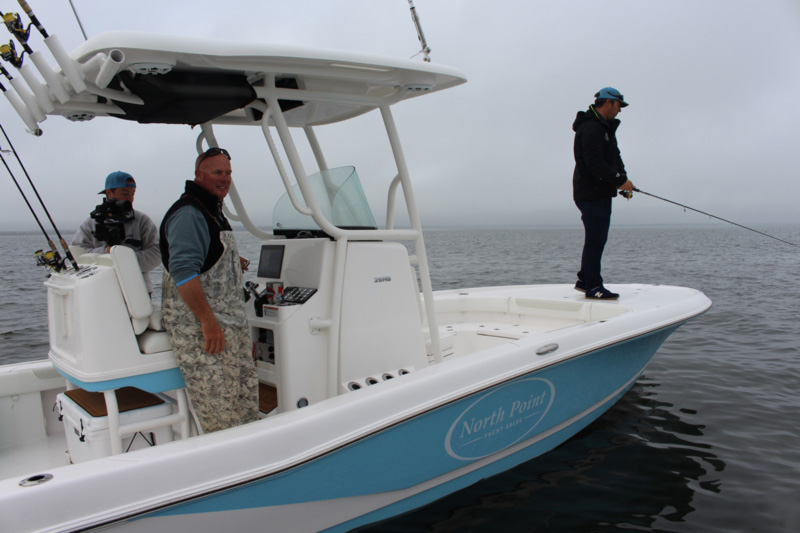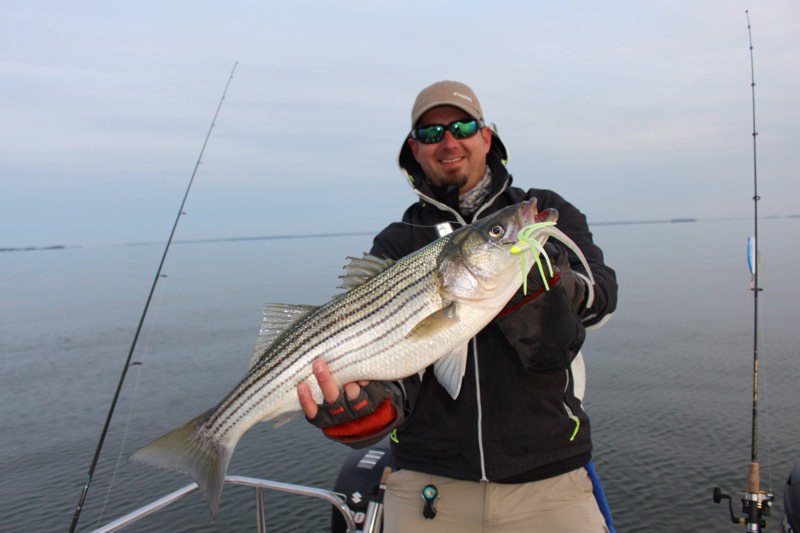You know the scenario: there’s patchy bait on the meter scattered at all depths, and you can see the telltale arches of big striped bass on the hunt. But they’re not sitting near bottom nor are they busting the surface, and to get them on the line you’ll need to present your bait right in front of their noses.

Challenging? Youbetcha. It’s far easier to bounce a jig along the bottom or streak one across the surface than it is to maintain a retrieve at a specific depth somewhere in-between.
Suspended Animation
Rockfish may suspend for any number of reasons. Thermoclines delineating a water barrier with comfortable temperatures on one side and good hunting on the other is one surefire trigger.(check out Humminbird thermocline screen shots for some great examples of what it looks like on-screen, if you're not sure). Oxygen levels are another. Stripers will also suspend simply as a matter of following their prey. And sometimes for no apparent reason that we mere human creatures can fathom, the fish will pick a particular depth range and stay there.
The biggest key factor to catching them? Pay attention.
No, we don’t mean “pay attention to what’s coming up next,” we simply mean that you have to focus your attention like a laser while trying to catch suspended fish. You can’t just toss your jig out there, retrieve it with this cadence or that one, and expect a hit. If the fish are at 20 feet, you need to put your jig at that depth and keep it there.
So: just how will you determine the depth your jig is running at? Here’s a partial list of all the variables affecting this not-so-simple equation:
- Weight of your lure
- Shape and composition of your lure
- Line type
- Line diameter
- Current
- Drift speed of the boat
- Drift direction of the boat
- Retrieve speed
- How far out you’ve cast (affecting line angle)
- How far in you’ve reeled thus far (also effecting line angle)
Heck, if you really want to go on a scientifical tangent, even things like temperature and water salinity will have some level of impact. Not even omnipotent Google has got an algorithm that can account for all these intertwining variables. And if it did, it would be thrown out of whack the moment you sat down your 2500 series spinner and picked up a low-profile baitcaster with a different gear ratio and spool size.

But never fear, dear angler, we can combat this confusing morass in a number of ways. The first tactic is the simplest one: unless the fish are very high in the water column, just wait until your jig hits bottom before beginning your retrieve. Then keep up a steady pace until it reaches the boat. At some point during that retrieve, you know you’ll be going through the strike zone.
Of course, using this tactic leaves a lot of room for error and your lure may only spend a fraction of its time where you need it to be. So cheat a little. If the fish are off of but relatively near the bottom, after doing a third of the retrieve stop and allow the jig to sink back down to the bottom before you start retrieving again. That way, you’ll be getting multiple passes through the strike zone.
What if the fish are higher up in the water column? Now, you’ll have to apply a different tactic: the countdown method. The theory is easy to understand. You’ll identify the sink-rate of your lure, then count after a cast to determine where it is in the water column.
To ID the sink rate, note the depth and flip your jig out, and count how long it takes to hit bottom. To use an example with exceedingly simple math, if you’re in 20 feet of water and it takes five seconds to hit, you know your lure sinks at around four feet per second. If it takes 10 seconds you know your sink-rate is two feet per second, and so on.
Now let’s say the fish are hovering at 10 feet, and your lure has a two-foot-per-second sink rate. Again, do some mercifully easy math in your head, cast out, and allow the jig to sink for five seconds before beginning your retrieve.
So much for the easy part — now things begin to get a little sticky. While you know the lure started out at the right depth, you also know it may sink below it if you retrieve too slowly, or rise up above it if you reel too quickly. If there’s a sure-fire way to nail down knowing the lure’s exact depth beyond this point, I sure don’t have it. With years of experience you’ll get a feel for how quick a crank is likely to raise that jig up and how slow is likely to let it drop, but even then, with all the potential variables coming into play, finding the ideal retrieve speed is always elusive.
This is, once again, where paying attention becomes critical. You need to cast, count, and keep track of retrieve speed as you bring the lure back at a fast pace, then a bit slower, and then slower yet. Fishing isn’t just about trying to catch fish, it’s also about fishing for information. And when you’re going through these motions and suddenly get a strike, you’ve gained intel. As long as you’re paying close attention to the factors in play, you can repeat them. And, if you’re nice, maybe even communicate them with the rest of the crew.
Jigging, Suspended
Time to throw another variable into the mix: your jigging style. If you make minor-league twitches of the rod tip as you retrieve, it probably won’t have much of an effect. But if you jig aggressively, it’ll make that lure zoom up and drop down between three to five feet. Yet again, additional variables come into play. Rod length and action, using braid versus mono, and whether you’re jigging side-armed or with more of an up and down angle will make quite a difference in how far the lure jumps up and then drops down. Note: a great way to wrap your head around how a lure dances as you jig is to take a number of different rods and rigs, cast them into a crystal-clear swimming pool, and watch the action with your own eyes — trust us, it is illuminating!

Since we’re never 1000-percent exactly just what depth the lure’s running at, IMHO, the default maneuver here is to always jig with as much up and down motion as possible, to cover as wide a swath of the depth range as possible. However, there will be times when the fish appreciate a more subtle jigging motion. So if big up-and-down snaps don’t work, by all means then do move on to less aggressive jigs of the tip. Just remember that you’re covering less of the water column, and may need to do more experimenting with sink times and retrieve speeds to nail down what will work.
Getting Vertizontal
Wait a sec—if we know the fish are at 10 feet, why not just let out 10 or 12 feet of line and jig vertically under the boat? Well, you can certainly try that. But if it doesn’t work in short order be quick to abandon the technique, because quite often suspended rockfish will strike a jig that’s moving along horizontally through the water column but won’t so much as sniff at one going straight up and down.
Okay. You see the scattered bait, and then you see the arches. You know what to do next. Now, pay attention…